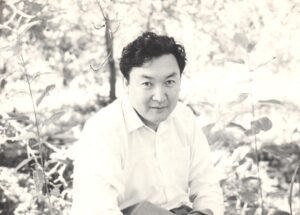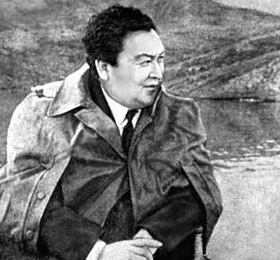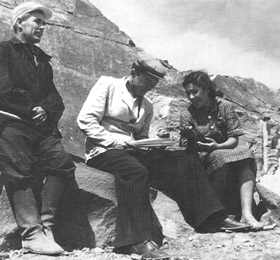YESSENOV: A LIFE-LONG EXPEDITION
August 5 marks the 95th anniversary of the birth of Academician Shakhmardan Yessenov. He is one of those without whom it is difficult to imagine today’s Kazakhstan. The trace that the scientist left in history determined the future fate of the country.
 Can you imagine, for example, that we do not have the Zhezkazgan, Zhanaozen, Karazhanbas, Zhetybai, Kalamkas, Bozashi, etc. deposits? Kazakhstan lives today by what was discovered by Yessenov and his associates back in the 50-60 of the last century. Can you imagine that al-Farabi’s scientific treatises were not published? That the first electronic computing center with the help of which geological exploration was carried out was not created? Can you imagine that Mangyshlak peninsula is the territory of Azerbaijan or Turkmenistan? The activity of this man determined the vector of development of Kazakhstan, became the foundation for rapid economic development and subsequent independence.
Can you imagine, for example, that we do not have the Zhezkazgan, Zhanaozen, Karazhanbas, Zhetybai, Kalamkas, Bozashi, etc. deposits? Kazakhstan lives today by what was discovered by Yessenov and his associates back in the 50-60 of the last century. Can you imagine that al-Farabi’s scientific treatises were not published? That the first electronic computing center with the help of which geological exploration was carried out was not created? Can you imagine that Mangyshlak peninsula is the territory of Azerbaijan or Turkmenistan? The activity of this man determined the vector of development of Kazakhstan, became the foundation for rapid economic development and subsequent independence.
– In 1962 after it became known about the huge reserves of minerals discovered there, Khrushchev wanted to transfer the entire territory of Mangyshlak to Turkmenistan and Azerbaijan, because they had extensive experience in the development of such deposits. But Yessenov defended Mangyshlak as part of Kazakhstan at a meeting in Moscow. He convincingly proved that the republic will cope with the development of the deposits. This is one of the great merits of Shakhmardan Yessenov, – said the academician’s contemporary Doctor of geological and mineralogical sciences, professor Khalel Bespayev (the scientist, unfortunately, left this world earlier this year).
Yessenov’s story began in the aul of Tartogai in the Kyzylorda region. When he was 13, the war began, so in childhood, adolescence, and youth he experienced a lot – wartime, the loss of loved ones, post-war challenges. At the age of 17, Shakhmardan left for Alma-Ata, enrolling in the Mining and Metallurgical Institute (now Satbayev University), becoming a student of well-renowned Kanysh Satpayev, who immediately took note of the talented boy, becoming a teacher, mentor and role model for him. After the institute, Shakhmardan worked for a long time in the then Dzhezkazgan region, first as a geologist, and then as the chief engineer of a geological exploration expedition. With his direct participation, the deposits named in the first paragraph of the text were discovered.
At the age of 33, he became the youngest minister in the USSR – the Minister of Geology of Kazakhstan. The people around him were impressed by his manner of speaking to the point, correcting along the way those who like to use official language and ornateness. He began the first visiting board of the Ministry with a debriefing.
– Yessenov opens the meeting and says: why things are going badly, let’s find out and also how we can help to solve the problems. Most of the participants remembered that first meeting with him for the rest of their lives. Guryev (now Atyrau) is a small provincial town. Such a meeting was held there for the first time. Immediately there was a rumor: there is a new young strong minister in the city, recalls Saduakas Kurmanov, Doctor of Geological and mineralogical Sciences.
Working under his leadership brought satisfaction to his team members. Minister Yessenov achieved the supply of new equipment, mastered and introduced advanced methods of geological exploration, encouraged those who are proactive, sought to increase efficiency.
Yessenov’s assistant in those years Alimkhan Yermekbayev adds:
– Everyone wanted to invite us to visit, there are a lot of people inviting us, but we don’t have much time. That’s why they even made a schedule: we had breakfast in one family, had lunch in another, and had dinner in a third house. That was the attitude and respect of the locals for him.
In the middle of the last century, the main research was carried out in two regions – Western and Central Kazakhstan, where discoveries of colossal deposits were made.
– At the Dzhezkazgan field, on a scientific basis, he managed to raise labor productivity by 5 times! He achieved an increase in the number of drilling rigs. This provided a huge leap in the economy of Kazakhstan, explains Marat Zhurinov, President of the National Academy of Sciences (NAS) of Kazakhstan.
After exploration and discovery of deposits at Mangyshlak peninsula, in order to prove the existence of huge reserves, Yessenov and his team had to collect and process huge amounts of data in the shortest possible time. The weight of the final paper report was 200 kg. But he managed to defend all the figures – the report was approved, despite pressure from above. The estimated capacity of the peninsula’s oil fields, according to those data, is 1.15 billion tons. All the work paid off handsomely, because not only oil and gas, but also brown coal were found on the territory of the current Mangystau region, along with strontium, manganese, chalk, table salt and other salts.
 Dosmukhamed Kshibekov, Doctor of Philosophy, Academician of the NAS of Kazakhstan says:
Dosmukhamed Kshibekov, Doctor of Philosophy, Academician of the NAS of Kazakhstan says:
– Then they began to develop Mangyshlak. The discoveries and the fact that there are personnel here who can professionally carry out this work gave Shakhmardan Yessenov grounds that he can safely take up work.
The geologist’s successes have awakened the entire desert peninsula to life. A small port town turned into a regional center, the first nuclear power plant was built there. The current heyday of Aktau, as the sea gate of Kazakhstan, is also due to the efforts of the academician and his colleagues at that time. The main university of Mangystau – the modern Yessenov University – is also actively developing today. The scientist really looked to the future. It was he who fully deployed the work begun under Satpayev. We are talking about creating and updating metallogenic maps, which indicate all open deposits and those places where minerals can be discovered in the future. The method of mapping and exploration that Yessenov used while working at the Dzhezkazgan field, they began to introduce it in other regions of Kazakhstan.
– This is a very painstaking work, many people were involved. There was an idea to make a series of such maps, and Yessenov was just at the beginning. This 11-volume book helped the institute that prepared them to survive in the dashing 90s, to stand on its feet, because then the first investors came to Kazakhstan, – says scientist-geologist, corresponding member of the NAS of Kazakhstan Eleonora Seitmuratova.
Shakhmardan Yessenov also paid great attention to how geologists live. He believed that their living and recreation conditions should be decent. When it was necessary to find sites for the construction of geologists’ settlements, housing, schools, medical posts, his authority always helped. The Ministry of Geology of Kazakhstan had 8 summer camps, where up to 3,000 children rested per shift. Adults spent vacations and restored their health in 5 sanatoriums across the country, which received up to 3,500 people per season. This happened already in those years when the subject of this article became a deputy of the Supreme Soviet of the Kazakhstan, and then the Supreme Soviet of the USSR.
The first president of the Academy of Sciences of Kazakhstan was Kanysh Satpayev, later – in 1972-1974 – his disciple Shakhmardan Yessenov took the post, again becoming the youngest of the presidents of the Academy. Under him, the number of scientific institutes has increased, research areas have expanded. He managed to ensure the rise and development of different sciences. Yessenov can also be considered the father of Kazakh seismology. At that time, Moscow did not agree to open the Institute of seismology also in Alma-Ata with those already operating in Frunze (Bishkek) and Tashkent. But our compatriot managed to prove the need to create such a scientific institution here.
He has always advocated the closest connection of science with production, having organized a scheme of close interaction of the NAS with the government of the country. At the forefront the scientist, practitioner and official in one person put the impact, the effectiveness of scientific research and the role that science could play in the modernization of the economy. The President of the Academy of Sciences also played a role in popularizing the works of the greatest scientist of the medieval East, al-Farabi.
– It was with his support that we managed to return scientific works, manuscripts of al-Farabi to Kazakhstan, because they were all abroad, in Europe: in the British Museum, in Spain, – the author of books about al-Farabi and Doctor of Philosophy Zhakypbek Altayev complements the portrait of Yessenov.
Yessenov’s initiative was also the organization of a scientific conference dedicated to the 1100th anniversary of the birth of a prominent Turkic scientist in Baghdad, Moscow and Alma-Ata. But the main thing is that Yessenov organized the publication of the most significant treatises of al-Farabi in large circulations. This work became possible due to the fact that he created the Department of Arabic Studies at the Institute of Philosophy, where he invited young and talented scientists with knowledge of Arabic and other foreign languages. By the way, Shakhmardan Yessenov advocated the rejuvenation of the scientific environment, organizing a meeting of young scientists of the Academy of Sciences of Kazakhstan in 1967, and the following year – a conference that gathered approx. 600 young scientists from all over the Soviet Union. He maintained his connection with the youth by teaching at his alma mater – the current Satbayev University. One of the first, back in the 60s, when the prerequisites for stagnation were already forming, he raised the issue of modernizing science. “The Kyzylorda nugget” proved his commitment to his ideas and principles not only by word, but also by deed, – he created the first electronic computing center in Kazakhstan in geological structures.
– He practically began to introduce computer technology in geology. He invited specialists from Moscow who conducted seminars and training, recalls Madeniyet Assanov, associate professor of the Department of Satbayev University.
– And then the first computer appeared at our department, – Vera Goryaeva, another veteran of geology, a corresponding member of the Academy of Mineral Resources of Kazakhstan, added to her colleague. – He personally went to Minsk and brought this computer. It was so big, it occupied half the room we had. And all the students started studying it.
In 1987, in collaboration with several scientists, his work “Calculation of reserves of geological blocks using a computer” was published. Today it has only historical significance, but then it was the latest word in the preparation of students. The separation of education from production, which became more and more noticeable in the 80s, was then one of the main issues that he seriously worked on. Do not forget that in the mid-60s, Yessenov also held the position of Deputy Chairman of the Council of Ministers of Kazakhstan. On his initiative, two research laboratories were created, which soon produced equipment for telephotometry themselves.
 The protagonist of this article made it mandatory to conclude contracts between scientific departments and geological exploration organizations. Thanks to this, Kazakh students went on practical expeditions to other regions of the USSR, gained experience and could feel part of a great science. Yessenov often invited the most prominent scientists of Kazakhstan, other republics and from abroad to the university, who gave lectures and conducted practical seminars with students. But Yessenov’s large-scale cases did not remain only in history. His achievements also affect today’s young, enterprising, striving for the development representatives of the newer generation. According to the maps compiled by Yessenov, exploration of the bowels of the earth continues, Aktau is developing, young men and women comprehend the wisdom of sciences in university classrooms. And in 2013, the descendants of the academician created a scientific and educational charitable foundation named after him.
The protagonist of this article made it mandatory to conclude contracts between scientific departments and geological exploration organizations. Thanks to this, Kazakh students went on practical expeditions to other regions of the USSR, gained experience and could feel part of a great science. Yessenov often invited the most prominent scientists of Kazakhstan, other republics and from abroad to the university, who gave lectures and conducted practical seminars with students. But Yessenov’s large-scale cases did not remain only in history. His achievements also affect today’s young, enterprising, striving for the development representatives of the newer generation. According to the maps compiled by Yessenov, exploration of the bowels of the earth continues, Aktau is developing, young men and women comprehend the wisdom of sciences in university classrooms. And in 2013, the descendants of the academician created a scientific and educational charitable foundation named after him.
– When we created the foundation, we were based on the continuity of values of different generations. At one time, Shakhmardan Yessenov followed the way of Kanysh Satpayev. Today we continue this work through our programs, support for young scientists and the development of the scientific potential of the country,” said Galimzhan Yessenov, the founder of the Shakhmardan Yessenov Foundation.
– Academician Yessenov was an outstanding scientist, he did a lot for the development of geological science. His works are of great applied importance: they continue to influence the economy of our country, – concludes Academician Zhurinov.
The chief geologist of the country – there is no such position, this title can only be given by the people. And the life of Shakhmardan Yessenov, whose 95th birthday is celebrated by the whole of Kazakhstan this year, is one big expedition appreciated by the people. Its main message is that a person can influence the future of his native land and that it is determined not only by the deeds and choices of the great people of the past, but also by each of us today.
5.08.22, Newsfeed
Seen by: 3,022




